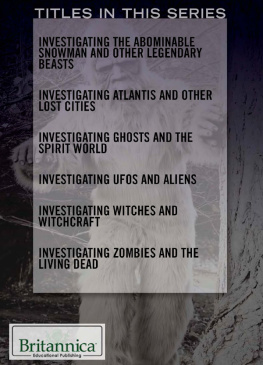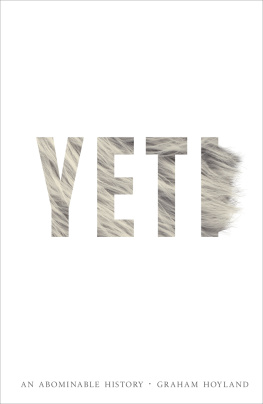
Published in 2015 by Britannica Educational Publishing (a trademark of Encyclopdia Britannica, Inc.) in association with The Rosen Publishing Group, Inc.
29 East 21st Street, New York, NY 10010
Copyright 2015 The Rosen Publishing Group, Inc., and Encyclopdia Britannica, Inc. Encyclopaedia Britannica, Britannica, and the Thistle logo are registered trademarks of Encyclopdia Britannica, Inc. All rights reserved.
Distributed exclusively by Rosen Publishing.
To see additional Britannica Educational Publishing titles, go to rosenpublishing.com.
First Edition
Britannica Educational Publishing
J. E. Luebering: Director, Core Reference Group
Anthony L. Green: Editor, Comptons by Britannica
Rosen Publishing
Hope Lourie Killcoyne: Executive Editor
Nelson S: Art Director
Nicole Russo: Designer
Cindy Reiman: Photography Manager
Library of Congress Cataloging-in-Publication Data
Nagle, Jeanne.
Investigating the abominable snowman and other legendary beasts/Jeanne Nagle.First Edition.
pages cm.(Understanding the paranormal)
Includes bibliographical references and index.
ISBN 978-1-62275-856-2 (eBook)
1. YetiJuvenile literature. 2. Animals, MythicalJuvenile literature. I. Title.
QL89.2.Y4N34 2014
001.944dc23
2014023131
Photo Credits:
Cover, p. 1 iStockphoto.com/twilightproductions; p. 5 Curioso/Shutterstock.com; p. 7 Science Source/Getty Images; p. 8 Fortean/TopFoto/The Image Works; p. 9 Nutexzles/Shutterstock.com; p. 10 Andrew Bardon/National Geographic Image Collection/Getty Images; p. 11 Ko Backpacko/Shutterstock.com; pp. 1213 Ed Vebell/Archive Photos/Getty Images; p. 14 Imaginechina via AP Images; p. 16 The Natural History Museum/The Image Works; p. 17 Fortean/TopFoto/The Image Works; pp. 1819 Daniel Prudek/Shutterstock.com; p. 20 Mary Evans Picture Library/The Image Works; p. 21 Fortean/TopFoto/The Image Works; p. 23 Jonathan Irish/National Geographic/SuperStock; pp. 24, 2627, 32, 3435, 42 AP Images; pp. 2829 Ernst Haas/Getty Images; p. 30 Royal Zoological Society of Scotland; pp. 33 Stephen Shugerman/Getty Images; pp. 3637 20th Century-Fox Film Corp. All Rights Reserved/Courtesy Everett Collection; pp. 3839 Douglas R. Clifford/Tampa Bay Times/ZUMA Press; p. 41 Hope Killcoyne; interior pages background images iStockphoto.com/Kivilvim Pinar, iStockphoto.com/mitja2.
CONTENTS
A people known as the Sherpas traditionally have treated the Himalayas, the mountains where they live, as sacred. They have built Buddhist monasteries at the mountains base, placing prayer flags on the slopes, and establishing sanctuaries, or safe spaces, for the wildlife of the valleys. For these reasons, the Sherpas have shown the mountains great respect, and for many years they would not climb them.
Mixed with their respect was a good amount of wonder and fear. For one thing, the Sherpas did not want to disturb or anger the gods and demons that were believed to live up in the high peaks. Also keeping them away was a mysterious creature that supposedly roamed the mountains lower slopes: the yeti, or the so-called Abominable Snowman.
A legendary creature, the Abominable Snowman is said to live in the Himalayas above the snow line. Although several attempts have been made to sight it, the creature has so far proved elusive, or hard to find. A lack of credible evidence has not kept stories about the yeti from being shared around the world. Some people insist that the creatureas well as other legendary beasts around the worldexists, while other people work to disprove, or debunk, the myths. Regardless, the search for the truth about the Abominable Snowman and other yeti-like creatures continues.

Prayer flags strung near a Buddhist shrine in Ladakh, in the Indian Himalayas. There have been reported yeti sightings in the region.
S tories about unusual animals were commonplace in earlier times. Such animals are called legendary because they exist only in these stories, or legends. The stories were often based on travelers reports of animals that were unfamiliar to them. Some famous legendary animals include the dragon, various sea serpents, the unicorn, and the phoenix.
Other legendary creatures resemble humans yet are not quite human. Even today some people speak of having seen these half-human, half-animal creatures, including the yeti, better known as the Abominable Snowman.
APPEARANCE
The word abominable means hateful or strongly unpleasant. That term is applied to the yeti mainly because it is said to look very fierce and scary. The creature is covered from head to toe in long, messy fur. Some people think that the creature is called a snowman because its fur is white. However, that assumption seems to be false. People who claim to have seen it say that the fur is actually a reddish brown color. So the yeti is called a snowman not because of its color but rather because of the weather conditions where it is believed to live.

Drawing of a yeti. With a human chest and body hair all over, this image shows why yetis are called man-beasts.
Various stories have given different measurements for how big and tall the Abominable Snowman is. Everyone seems to agree, however, that the creature is at least six feet (about two meters) tall. Some stories claim that it is two to four feet (about a half meter to a little over a meter) taller than that.
People who say they have seen the Abominable Snowman are able to guess at its height because, apparently, the creature walks on two legs, like a human. Yet some accounts discuss how sometimes it gets down on all fours, meaning it uses its arms as legs, when running or moving quickly. Still other stories note that the creature places the knuckles of its hands on the ground, so that it moves sort of like an ape or gorilla.
COUSIN OF THE WOODS
Bigfoot, or Sasquatch, is supposed to be a lot like a yeti. The creature is thought by some to live in the northwestern United States and western Canada. Bigfoot has been described as being anywhere from 6 to 15 feet (2 to 4.5 meters) tall, standing up and walking on two feet. Some people say it lets out a cry, while others say it doesnt make a sound. Bigfoot is supposed to smell bad as well. Despite many claims of sightingsof mysterious footprints or of the beast itselfmost scientists do not believe that Bigfoot exists.

This is the well-known freeze-frame of the famous Patterson-Gimlin film from 1967, which supposedly captured a Bigfoot in midstride in the hills next to Bluff Creek, in the wilderness near Orleans, in Northern California.
LOCATION
The Abominable Snowman is said to roam the Himalayan slopes of Kanchenjunga, the worlds third-highest mountain. The mountain is in the Indian state of Sikkim, located in the northeastern part of the country, along the border with Nepal. Some two-thirds of the state consists of mountains that are snow-covered year-round.
The area has long been considered sacred, which means holy. Buddhist monasteries have been built at the base of the mountains, and the Sherpas place prayer flags on the slopes. Just below the timberline, or the place on a mountain slope where tree growth stops, is where the Abominable Snowman is said to live. Forests near the timberline offer a place for the yeti to hide when it is not out on the slopes looking for food.


















